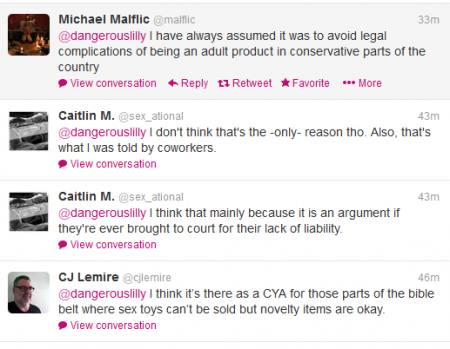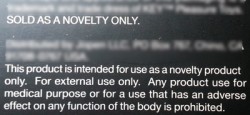“For Novelty Use Only” Part 1
The sex toy industry is rife with half-truths, flat-out lies, confusing names for materials and more. When information is put out there that seems to make sense and seems credible, it gets passed on and shared until it’s viewed as fact. A prime example is that, for awhile, we all believed that a sex toy had to contain at least 10% silicone in order to be labeled as just merely “silicone” by the manufacturer (as if 10% silicone mixed with 90% PVC somehow makes it better….hint: it doesn’t) but I found out at CatalystCon’s Toxic Toys session in March that that isn’t true at all. In fact, they can claim whatever they want if they’re unethical. And some are.
 Imagine my surprise when an industry friend, who knows how much I love to write about things like this, tells me that the “Novelty” term is used mainly because of export and tariffs….NOT to create a legal loophole relieving them of responsibility if you get injured, or because they don’t care. True, I’m sure some companies don’t care. But the “Novelty” disclaimer isn’t 100% indicative of that. It does absolutely nothing to relieve the company of legal liability.
Imagine my surprise when an industry friend, who knows how much I love to write about things like this, tells me that the “Novelty” term is used mainly because of export and tariffs….NOT to create a legal loophole relieving them of responsibility if you get injured, or because they don’t care. True, I’m sure some companies don’t care. But the “Novelty” disclaimer isn’t 100% indicative of that. It does absolutely nothing to relieve the company of legal liability.
I’ve seen a shit ton of blame being laid on China and companies who use the “Novelty” disclaimer as to why there are so many “bad” sex toys. You’ll find many articles online that talk about toxic toys and they will also usually fall back on the “blame the novelty tag”. I did too, because when I first wrote my posts, I was calling on what I’d found. This is how it happens; I couldn’t find anything to the contrary, so I figured it must be true! It’s a confusing subject. The subject of this post is something I’ve been researching for literally months. I wanted to get as many ducks in a row as possible before writing, and see if I could really nail down facts and get back-up information to everything my friend below told me. And I couldn’t. I couldn’t get straight answers from many of the manufacturers. I’ll be sharing all of that in Part 2 but for now I’m working on the basic debunking.
My friend needs to remain anonymous because they have worked for a few manufacturers and by extension, retailers, in their time in the industry. This is what they had to say on the subject:
From a stand point of importing into the US, it has more to do with the cost of customs fees and duties and possible certifications that may be required depending on how it’s classified. In regards to exporting products to other countries, each country has their own regulation in what they will accept on packaging or product descriptions. Some companies have started omitting the words “for novelty use only” on the packaging, but my understanding is in those cases they are registered (not approved) with the FDA.
Everything is imported or exported under what’s called a Harmonized Tariff Schedule Code (Harmonized Code). This code determines the customs fees and duties that will be paid on every shipment coming in to this country and are based in part on 1) materials and 2) intended use.
So basically, the bottom line is the wording that is chosen can effect the cost of the product when importing to the US and exporting to other countries. In addition, if certain wording is used (ie. “toys” without the word “novelty”), manufacturers face the possibility of needing additional certifications for the US & EU and the possibility of certain non-US countries denying shipment altogether. The only reason anyone tries to “skirt” the FDA is for customs fees, duties and taxes. It has nothing to do with the quality of the product, but rather cost of importing. When importing to the US (and possibly exporting, depending on the country), if any products are labeled as “toys” (or NOT labeled as “For novelty use only/not intended as a medical device”) then they may be subject to Consumer Product Safety Improvement Act of 2008“.
What about the legal loophole theory? I talked with K.M. Davis, a lawyer who has worked with numerous adult industry companies. I asked: “DOES the disclaimer make any lawsuit null and void? What if a company claims their product is phthalates-free, but a customer gets a chemical burn from using it, sends it off to be lab-tested and finds a bunch of toxic chemicals. Can they sue?”
I can say, having worked with manufacturers in a number of industries, not just sex toys, that there is often a “what is everyone else doing, I better do that too” mentality among lawyers, insurance folks and manufacturers related to disclaimers. So, often one company ends up putting something on their packaging for no better reason than “everyone else was doing it.”
I have heard speculation among industry folks that the “novelty use” disclaimer is an attempt to avoid lawsuits if a consumer somehow injures themselves using the product (either because it is toxic or a bad design) and have heard others speculate that it is used to avoid potential prosecution if the products are sold somewhere where sex toys are banned or regulated. However, nothing can make a lawsuit null and void, as a judge is always free to say that despite a disclaimer, the manufacturer could reasonably have known what the consumer would use it for.
As to saying your product is free of something but not actually being free of that, because sex toys are completely unregulated, there’s really not much a consumer can do. One could sue if they tested something and found the claim untrue, but you’d have to prove what your personal damages were1. It’s unlikely anyone would want to pursue that claim either, which is what manufacturers rely on….
Here’s the tl;dr for Part 1:
1. They’re likely doing it because it’s just always been done, and the company lawyers are sticking with tradition.
2. You can still sue
3. It’s likely more for exporting reasons than anything else, for most companies – if it’s not “novelty”, then the FDA thinks it is medical and they will require formal approval, photos, and a 3-page paper written on the subject. In blood2.
So should you avoid all companies who use such disclaimers? What about the companies who don’t use the warning words? Come back for Part 2 next week!
- Meaning: If you suffered chemical burns, you’d have to hope that your doctor knows it’s a chemical burn and not try to treat it as an infection. You have to be upfront with your doctor. Then you’d have to get the funds for testing the sex toy from an accredited lab. Then find a lawyer, like Davis. It’ll be a years-long event, I’m sure ↩
- I might be exaggerating a little… ↩







Loved this, I’ve really been wondering about the “novelty use” tag, especially since I’ve once or twice seen it on the products of companies that I pretty much trust.
Can’t wait for part 2.
I had originally been told that the “novelty use” thing was kind of the same as the “make the toy be an animal or have a face because then it’s not a “sex” toy” thing. The liability part only occurred to me after Toxic Toys. I love that you’re writing about this!